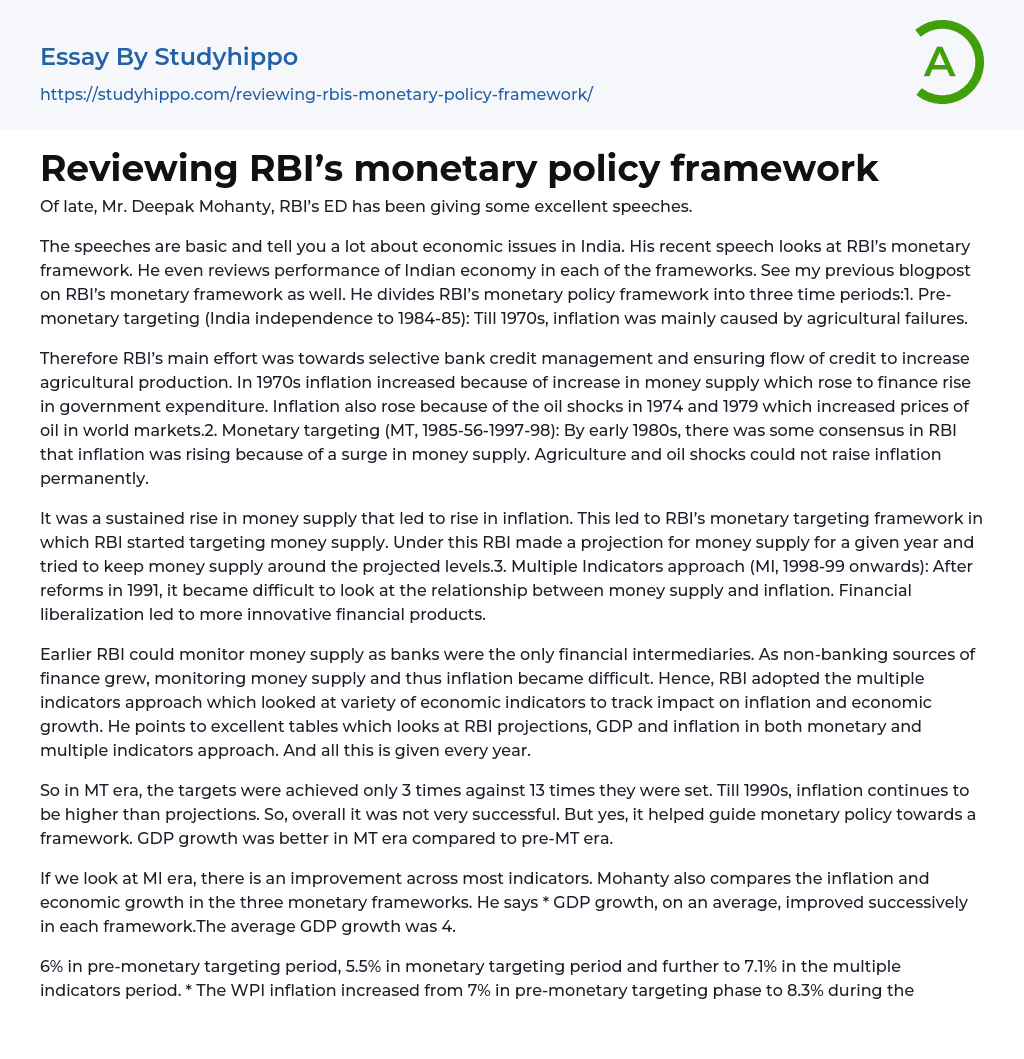Recently, the speeches given by Mr. Deepak Mohanty, Executive Director of the RBI, have been outstanding.
In his speeches, he discusses economic issues in India and provides insights into RBI's monetary framework. Specifically, his recent speech focuses on reviewing the Indian economy's performance in each framework, with a focus on the pre-monetary targeting period from Indian independence to 1984-85. In this period, inflation was primarily driven by agricultural failures. To learn more about RBI's monetary framework, refer to my previous blog post.
The RBI's primary objective was to manage selective bank credit and ensure its flow to enhance agricultural production. In the 1970s, inflation increased due to a rise in money supply that funded government spending and oil crises of 1974 and 1979 resulting in a surge in global oil prices.
From 1985-86 to 1997-98, during the Monetary Targeting period, there
...was a consensus within the RBI that inflation escalation resulted from an increase in money supply rather than just agricultural or oil shocks alone.
The increase in inflation was caused by a continuous increase in the money supply. The RBI responded by implementing a monetary targeting framework that focused on controlling the money supply. This involved projecting the money supply for a given year and maintaining it around the projected level. After reforms in 1991, it became challenging to assess the relationship between money supply and inflation. This led to the implementation of the Multiple Indicators approach (MI) from 1998-99 onwards, as financial liberalization resulted in more advanced financial products.
Previously, the Reserve Bank of India (RBI) could easily monitor the money supply since banks were the sole financial intermediaries. However, as non-banking financial sources expanded, keeping track o
inflation and money supply became challenging. Therefore, RBI implemented the multiple indicators approach which involved examining various economic indicators to observe their impact on inflation and economic growth. The author refers to informative tables that illustrate RBI projections, GDP, and inflation using both monetary and multiple indicators approaches. These tables are released annually.
During the MT era, targets were only met three times out of 13 that were set, making it overall unsuccessful in achieving its goals. Inflation remained higher than projections until the 1990s. However, it did provide guidance for monetary policy and resulted in better GDP growth compared to the pre-MT era.
When examining the MI era, there is a positive change in various indicators. Mohanty compares inflation and economic growth in three monetary frameworks and notes that, on average, GDP growth has progressively improved in each framework. Specifically, the average GDP growth was 4.
In the pre-monetary targeting period, inflation stood at 6%. In the monetary targeting era, it decreased to 5.5% before climbing back up to 7.1% in the multiple indicators phase. During this time, WPI inflation increased from 7% to 8.3%.
The significant increase in fiscal deficit during this period contributed to a decrease in both WPI and CPI inflation according to the multiple indicators approach. The reduction in inflation was linked to a significant decrease in fiscal deficit, emphasizing the necessity of fiscal consolidation for maintaining high levels of growth while ensuring price stability.
Thirdly, although the volatility of WPI inflation decreased during the period of multiple indicators, it rose for CPI inflation, indicating higher instability in the prices of food. This highlights the significance of supply management and a greater emphasis
on agricultural development to control inflation in food prices.
Fourthly, the growth of money supply (M3) decreased throughout the periods, although the volatility of M3 slightly increased during the multiple indicators approach due to the growing importance of interest rate in monetary transmission. There was a noticeable decrease in overnight interest rate with lower volatility, which reflects the shift in operating objective to stabilise overnight interest rate so that it transmits through the term structure.
Fifthly, on average, both in nominal and real terms, the exchange rate has experienced consecutive depreciations. Nevertheless, it has become more stable during the multiple indicators approach than under the monetary targeting regime.
The recent improvement in macroeconomic performance can be attributed to various factors. One of them is the accumulation of reserves and management of exchange rate to control volatility. Another factor is the supportive fiscal policy which includes discontinuation of automatic monetization and rule-based deficit reduction program under FRBM Act. This has enhanced instrument independence of the Reserve Bank and improved the performance of monetary policy. However, apart from monetary policy, productivity enhancing structural reforms, increasing saving and investment, global integration, low global inflation environment, and private sector's entrepreneurial spirit also played an essential role in the overall improvement.
- American Dream essays
- Barriers To Entry essays
- Capitalism essays
- Central Bank essays
- Compensation essays
- Consumerism essays
- Economic Development essays
- Economic Growth essays
- Economic Inequality essays
- Economic System essays
- Economy essays
- Employment essays
- Export essays
- Finance essays
- Free Trade essays
- Gross Domestic Product essays
- Human Development essays
- Income Inequality essays
- Industry essays
- Inflation essays
- International Business essays
- International Trade essays
- Macroeconomics essays
- Materialism essays
- Max Weber essays
- Microeconomics essays
- Minimum Wage essays
- Monetary Policy essays
- Monopoly essays
- Pricing essays
- Profit essays
- Recession essays
- resources essays
- Taxation essays
- Trade essays
- Unemployment essays
- Warehouse essays
- World economy essays
- Activism essays
- Communism essays
- Conservatism essays
- Liberalism essays
- Marxism essays
- Nationalism essays
- Patriotism essays
- Policy essays
- Public Policy essays
- Social Contract essays
- Socialism essays
- Totalitarianism essays


Unfortunately copying the content is not possible
Tell us your email address and we’ll send this sample there.
By continuing, you agree to our Terms and Conditions.


